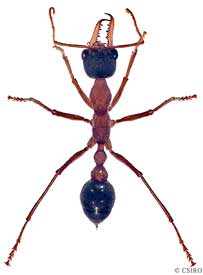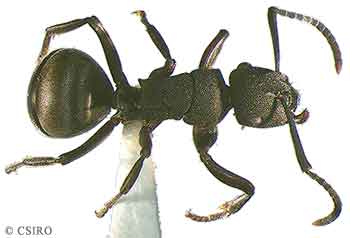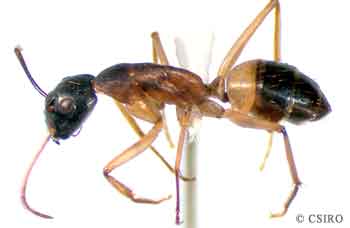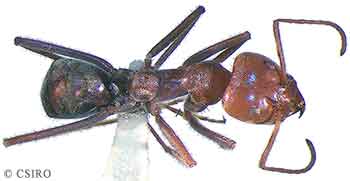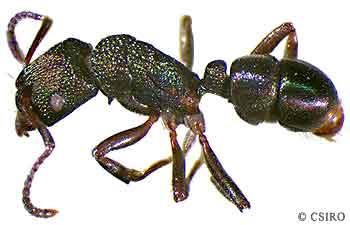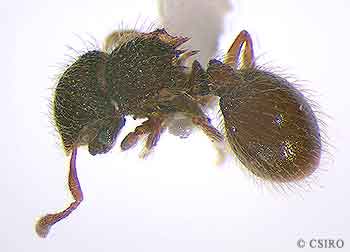
|
|
| ||||||||||||
|
Ants are one of the most familiar and easily recognised groups of all the insects. One of the quickest ways to recognise these insects is to look at their antennae. Ants, unlike some wingless wasp species which they may be mistaken for, always have elbowed antennae, with the scape nearly as long as the rest of the segments past the elbow. Ants also have the characteristic 'wasp waist', which usually consists of one or two knobs rather than the single section of other hymenopterans. The mandibles of most ants are quite prominent and many species have an ovipositor capable of delivering a painful sting. Ants have evolved the most advanced social structures found in insects and most live in social colonies which may be small, less than 100 individuals or with more than a million members. Each colony is made up of different castes and usually includes: 1. A Queen: who lays all the eggs, is winged at birth but loses them after mating, there may be more than one queen in a nest. 2. Workers: wingless sterile females who build the nest and tend to the queen, larvae and pupae. Workers may be separated into workers and soldiers. Soldiers are used for colony defence and often have very large heads and mandibles. 3. Males: who have wings and whose only role is to mate with the new queens. Ants have one of the most varied diets of all insects. They will feed on a variety of substances including dead animal matter, other insects, seeds, fungi, nectar and honeydew produced by scale insects and aphids. When out foraging an ant who finds a food source returns to the nest leaving a trail of pheromones which are chemicals that stimulate other ants. Other ants then follow the trail to the food and take more back to the nest resulting in the processionary behaviour often observed. Myrmecia species (bull ants, bulldog ants) Bull ants or bulldog ants are familiar to most Australians due to their large size and very painful sting. These ants can be separated from most other ants by their large eyes and long, straight, well-toothed mandibles. Most bull ants construct mound nests in the soil which may be covered with small stones or fragments of plant material. These ants are aggressive and have well developed sight and when disturbed often come swarming rapidly from the nest straight towards the intruder with jaws open and stings at the ready. Bull ants are considered to be some of the most primitive ant species and only have relatively small colonies. The workers are solitary hunters and unlike many other ant species do not form scent trails when foraging. Instead bull ants forage independently and upon finding food carry it back to the nest. Despite their aggressive nature adult bull ants feed predominantly on honeydew, nectar and other sweet substances, but their larvae are carnivorous and are fed on insects collected by foraging workers. Bull ants are most active during the day and forage either on the ground or on low vegetation.
Polyrhachis species This is a very large and distinctive group of ants found throughout Australia. They can be distinguished by the presence of spines on the mesosoma and the top of the petiole. Most Polyrhachis species are black in colour and range from 5-10 millimetres in length. Polyrhachis species mainly build their nests in the ground either under rocks and logs or in the open. A few species from the tropics are known to construct arboreal nests made from plant fibres or nest in the hollows of trees. Polyrhachis ants are relatively shy and will retreat back into the nest when disturbed. Adults can often be observed at night foraging on vegetation during warmer weather, although some species may forage during the day. Polyrhachis species have a varied diet, collecting nectar and consuming both plant and animal matter.
Camponotus species (sugar ants)
Commonly called sugar ants, Camponotus species occur in most parts of Australia. Camponotus is one of the largest groups of ants in Australia and species vary greatly in shape, size and colour. These ants can range from 2.5-15 millimetres in length and are some of the most often seen ants due to their size and often bright colouring. Camponotus species can be found nesting in a variety of sites ranging from holes in wood to the roots of plants, in twigs of trees and shrubs, between rocks or in the soil. They are mostly nocturnal and workers can often be seen heading out at dusk along marked trails to forage for food, and travelling back to the nest at dawn. Sugar ants can also be seen during the day however they are most active at night. Sugar ants belong to a group of stingless ants and although unable to sting do possess strong mandibles which can bite. In self-defence these ants are also able to spray acid from their abdomens to deter predators.
Camponotus consobrinus is probably the most familiar species of the Camponotus group as they are a common sight in many suburban areas. These large yellow and black ants are often seen during warm weather heading out from their nest at dusk to gather food or foraging for insects under lights at night. Iridomyrmex species (meat ants)
Iridomyrmex species are usually the most frequently encountered ants in Australia. This large group of ants are also one of the most ecological important groups due to their aggressive nature and high abundance. Many species often form large colonies with well-defined boundaries which are aggressively patrolled by workers. In areas where large colonies occur the numbers of other species is significantly reduced by the presence of Iridomyrmex nests and their aggressive members. Iridomyrmex species build nests in the soil which, depending on the species may consist of large conspicuous mounds covered in small pebbles with many entrance holes or more cryptic nests which have only a single small entrance hole. Most Iridomyrmex species are scavengers, taking a wide variety of food which may include nectar, animal material both living and dead and plant matter such as seeds. Some species also tend aphids and other Hemiptera for the honeydew they produce.
Iridomyrmex purpureus are commonly known as meat ants and are possibly the best known of all ant species in Australia. Their distinctive purple and black colouring as well as their gravel covered mound nests are seen almost everywhere. In the cooler southern parts of the country meat ants may not be very active during the winter. However, during the warmer months they can be seen foraging across wide areas and if disturbed will come surging from the nest to defend against intruders. Meat ants do not sting but have strong mandibles with which to bite. Meat ants collect a wide variety of foods and can often be seen 'farming' other insects such as lerps and scale for the sweet honeydew they offer. Rhytidoponera species Rhytidoponera are some of the most common ant species in Australia with over 100 species occurring across the country mostly in either the tropics or the more arid areas. These ants occur in a wide range of habitats and are often very abundant in disturbed habitats, being able to successfully colonise urban areas such as parks, gardens and yards. Rhytidoponera build their nest on or in the ground and may be found under rocks and logs, in rotten wood or out in the open. Nest in open ground often consist of small, messy earthen mounds or larger mounds decorated with small pebbles, leaves or twigs. Most Rhytidoponera are scavengers or predators although some species may also collect honeydew or seeds. These ants can often be seen foraging on the ground or among low vegetation either singularly or in small groups and foraging times usually vary depending on the environment. In drier areas Rhytidoponera mostly forage in the evening or during the night, while those in wetter habitats or forested areas often forage during the day. Some species of Rhytidoponera are either unable to sting or have a weak sting only, while some species have quite a painful sting considering their small size.
Rhytidoponera metallica or green ants as they are commonly called occur over most of southern Australia and are often found in urban areas such as parks and gardens. Green ants are highly adaptable and can tolerate a wide range of environmental conditions. They are easily recognised by their iridescent green colouring and are often felt before they are seen. Many a person has been taken by surprise by sitting down in lush grass only to be painfully stung by these cryptic ants while they are out foraging on the ground. Meranoplus species Meranoplus is a very large group of ants found mostly in the drier and hotter areas of Australia. All species are characterised by having a shield-like plate on the upper surface of their body. When disturbed these ants lie motionless, tucking their legs under this protective plate and drawing their antennae into special grooves on the side of their head. This along with their often hairy bodies makes them almost invulnerable to attack from other ants. Meranoplus species nest on the ground and can usually be recognised by the piles of discarded seeds and seed coats around the entrance. Nests may consist of a small mound of dirt around the entrance hole or a larger depression. Most Meranoplus species are scavengers, taking a wide variety of food although some species specialise in collecting seeds. Foraging workers can often be seen moving slowly along the ground or on the trunks of trees mostly during the day, although some may forage at night.
To learn more about the types of ants found in Australia see the Australian Ants Online website. For more ant species visit the Australian Insect Common Names - Formicidae section found here. |
